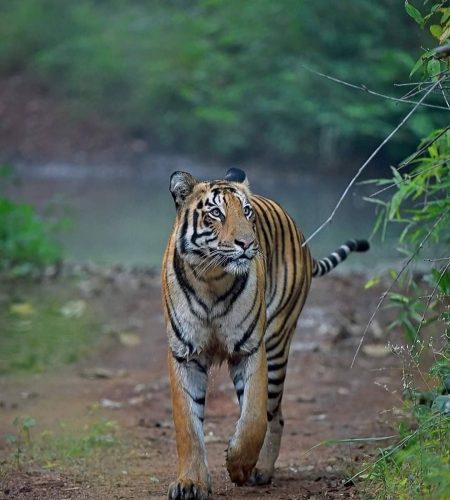Nagzira Tiger Reserve

Welcome To Nagzira Tiger Reserve
Nagzira wildlife sanctuary is located in the Gondia district of Maharashtra at . Nagzira Wildlife Sanctuary is locked in the arms of nature and adorned with a picturesque landscape, luxuriant vegetation and serves as a living outdoor museum to explore and appreciate nature. This sanctuary has a number of fish, 34 species of mammals, 166 species of birds, 36 species of reptiles and four species of amphibians.Theinvertebrate fauna includes, besides a number of insects and ant species. Wild animals found here are the tiger, bison, sambar, nilgai, chital,wild boar, sloth bear and wild dog. Nearly 30,000 tourists visits this sanctuary annually. Wild animals to spot are the tiger, panther, bison, sambar, nilgai, chital, wild boar, sloth bear and wild dog. There are also tigers, panthers and one elephant named Rupa.
Etymology
It is said that there were once elephants (‘Nag’ means Elephant in Sanskrit) in this forest, which is how the name Nagzira came to be. The majority of the dwellers here are tribal. Because of dense forests the wildlife is also rich. Another special feature of this region is its lakes which have helped for the faster growth of jungles.[2]
History
The Gond kings once ruled these forests in the vicinity of the Gondia. In 1970, 116.54 km2 (45.00 sq mi) was declared a Wildlife Sanctuary. In 2012, state government announced to merge this sanctuary with another national park to include in Tiger Project.
Significance
The Nagzira wildlife sanctuary is a miraculously preserved “Green Oasis” in the easternmost part of the Maharashtra State and has a great importance from bio-diversity conservation point of view. This sanctuary is locked in the arms of nature and adorned with picturesque landscapes, luxuriant vegetation and serves as living outdoor museum to explore and appreciate nature. This wildlife sanctuary is indeed nature’s priceless asset and beckons one and all to enjoy its picturesque landscape, its scenic beauty, its pure and fresh air. It is really a boon to us and hence we must realise the real worth of this marvelous treasure house of nature and must protect it as a part of our national heritage.It has got immense potentials from bio-diversity conservation point of view and its values are discussed below.
Ecological or Environmental values
It is an important conservation unit in Central India in general and Vidarbha in particular. It acts a “Green-lung” for the adjoining human settlements and helps in maintaining the environmental balance.
Zoological values
It is home of many endangered species. The vertebrate fauna includes, besides a number of fishes, about 34 species of mammals, about 166 species of birds including migratory land and water birds, about 36 species of reptiles and about 4 species of amphibia. This sanctuary is notable for its wealth of birds and is indeed a bird watcher’s paradise. The zoological values of this sanctuary are briefly given below.
Invertebrates
This sanctuary is the abode of, besides innumerable other insects and ants species, about 49 Butterfly species belonging to 9 families, the important species among them are Common Rose, Common Mormon, Lime Butterfly, Common Sailor, Common Indian Crow, Black Rajah etc.
Mammals
Nearly 34 – species of mammal belonging to about 8 natural orders and 16 families are seen in this sanctuary, out of which about 14 species are of endangered status, namely Tiger, Panther, Jungle Cat, Small Indian Civet, Palm Civet, wolf, Jackal, Sloth Bear, Ratel, Common Giant Flying Squirrel, Gaur, Four Horned Antelope, Mouse Deer, Pangolin.
Birds
The avifauna of this sanctuary is it’s most attractive wildlife feature. Well over 166 species belonging to about 16 different orders and 47 families have been recorded here. Also as many as 15 species of migratory birds and about 42 species of local migrants are reported. One remarkable bird, “Bar-headed Goose” which is a winter migrant from Ladakh and Tibet inhabits Chorkhamara tank located adjoining the sanctuary. There are 13 bird species of endangered status including peafowl and the birds belonging to “Accipitridae” family.
Reptiles
This sanctuary is the abode of about 36 species of reptiles belonging to 2 natural orders and 11 families out of which about 6 species are of endangered status namely Indian Rock Python, Dhaman, Indian Cobra, Russel’s Viper, Checkered Keelback and Common Monitor.
Amphibia
This sanctuary is a home of many interesting varieties of frogs and toads like Tree-frog, Bull-frog, Six-toed frog, an uncommon toad; Ramanella Montana etc.
Fishes
The Nagzira lake and the other water-bodies in and around this sanctuary abound in many varieties of fresh water fishes.
Botanical values
One of the unique features of this sanctuary is the existence of diverse vegetation type ranging from dry mixed forests to moist forests. Its forests belong to the category of “Southern Tropical Dry Deciduous Forests” – 5A/C3 as per the revised classification of the forests by Champion and Seth. This sanctuary serves as a living repository of various economical, medicinal, aromatic, ornamental plant species. Nearly 200 tree species are seen in this sanctuary.
Geological values
This sanctuary exhibits an amazing diversity of terrain and the altitude ranges from nearly 30 meters to about 560 meters above the mean sea level, which is the highest point of the sanctuary. The typical geological formations are Sakoli Series having number of formations made of phyllites, slates, chlorites etc. and Saucer Series. The rocks of the two groups appear to show difference in chemical composition of lime bearing rocks. The mineralogical difference is that the rocks of Saucer group commonly contain Felspar and Biolite but no chlorite whereas those of Sakoli group contain invariably chlorite, rarely Biolite and no Felspar. All this is coupled with a diversity of terrain having steep ridges, narrow valleys and deep gorges with varying altitude.
Watershed values
This sanctuary forms the catchments of the Nagzira lake, Thadezari Lake, Chorkhamara Lake, Bodalkasa Lake, Rengepar Lake, Murpar Lake, Lendezari Lake, Malutola Lake, Balapur Lake, Pindkepar Lake, Bodbadya Lake etc. Which are important from agricultural point of view. These lakes are also important for fishing purposes.
Cultural values
On the border of the sanctuary, Mohaedo Temple at Pongezira attracts the people from the various parts of the state and also from the adjoining Madhya Pradesh who come in thousands during Mahashivratri.
Bio-geographic zonation
As per the Biogeography classification adopted by Wildlife Institute of India, Duration, this sanctuary is classified as follows. i) Bio-geographic Kingdom – Paleotropical ii) Sub Kingdom – Indomalaysian iii) Bio-geographic Zone – 6 – Deccan Peninsula iv) Biotic Province – 6 B – Central Deccan. This Bio-geographic zone is one of the least protected bio-geographic zones in India, rich in floral and faunal diversities. Hence it needs high degree of Protection.
Forest types
The sanctuary has a diversity of plant community. The major forest type is “Southern Tropical Dry Deciduous Forests” – 5 A/c 3 as per Champion and Seth’s Classification
Museum
Museum and Interpretation Center
Presently a small museum at Nagzira tourist complex is being used for conservation education of tourists. Here varieties of stuffed birds are kept in showcases. Some animal models, butterflies are also displayed at museum. Also some photographs on wildlife, pugmarks, hoot-prints, plaster casts etc. are also exhibited to educated the tourists. This Museum is at its infancy and needs lot of further improvements. Very few tourists visit the museum/ Interpretation Center.
Ausitorium and audio-visual materials
Presently museum/ interpretation center is use as an auditorium to screen informative films and slides on wildlife, forests and nature. At present there are 8 films are lent out occasionally to other institutions like schools, colleges and other forest divisions. At present only one 16 mm film projector, one 35 mm slide projector, one overhead projector as well as two tape recorders are available with the sanctuary. As there is no electricity within the sanctuary, the generator is used to operate these facilities. Hence there is no need to develop facilities within the sanctuary.
Hides and machans
At present there are 5 watch cabins and 5 watchtowers located within the sanctuary. This facilitates wildlife observation. The existing number of watch cabins/watch tower is quite inadequate and hence there is need to erect more watch cabins/ tower within the sanctuary during the plan period.
Other places to visit near Nagzira
Nearby attractions include Navegaon National Park (50 km), Itiadoh Dam (65 km), Tibetan Camp at Gothangaon (60 km) and Pratapgad (70 km)
Nagzira Wildlife Sanctuary (60 km), Itiadoh Dam (20 km), Tibetan Camp at Gothangaon (15 km) and Pratapgad (15 km) are the places of interest around the national park.
Nearest airport is at Nagpur (150 km), while nearest railhead is at Deulgaon (2 km). Nearest bus stand is Navegaon at a distance of 10 km.
Visiting Timings in a year : October 1 – January 31 – 7 am to 6 pm. February 1 – June15 – 7 am to 7 pm.
June 16 – September 30 – Closed.
Weather : For most of the year, temperatures are moderate and pleasant. The best time to visit is during April and May.
Location
State: Maharashtra District: Gondia Tahsil: Situated in Arjuni (Sadak), Goregaon & Tiroda Tahsils of Gondia District. Circle: Geographically the area of this sanctuary comes under the Nagpur Circle of the State Forest Department. The administration and management of this sanctuary comes under the control of the Chief Conservator of Forest (Wildlife), Nagpur. Division : The administration and management of this sanctuary comes directly under Conservator of Forests (Wildlife), Gondia. Ranges: The area of this sanctuary comes under the Nagzira range.
By road
Nagzira wildlife Sanctuary is situated only 22 km. away from Sakoli on the National Highway No. 6 (Bombay – Calcutta) which passes through Sakoli. The sanctuary is situated at the distance of about 60 km from District H. Q. Gondia and 120 km. away from Nagpur. Nearest bus-stand is at Sakoli & Tirora.
By train
Nearest railway stations are ; a) Gondia 25 km b) Bhandara Road 50 km c) Soundad 20 km d) Tirora 20 km
By air
The nearest airport is Nagpur (~120 km) and Gondia (for private planes).
Numbers Speak!

An Ideal package includes One safari drives in to the park, One cycles of meals (BLD). Basic Package is for six persons, sharing the room in double occupancy and using single jeep for safaris.It doesn’t mean that we do not cater to single / couple travelers.Yes of course we do, you may please discuss with us, our specialist will help in designing a bespoke itinerary for you. Please enquire for detailed itinerary.

Nagzira Package
1 Night / 2 Day Package Ex Nagpur
Package Cost
₹ 7,000/- per person
Included
- 1 Night accommodation on twin sharing basis
- One Breakfast, Lunch & Dinner
- 1 Jungle drive
- Ex. Nagpur Ac Vehicle transfer
- All Taxes
